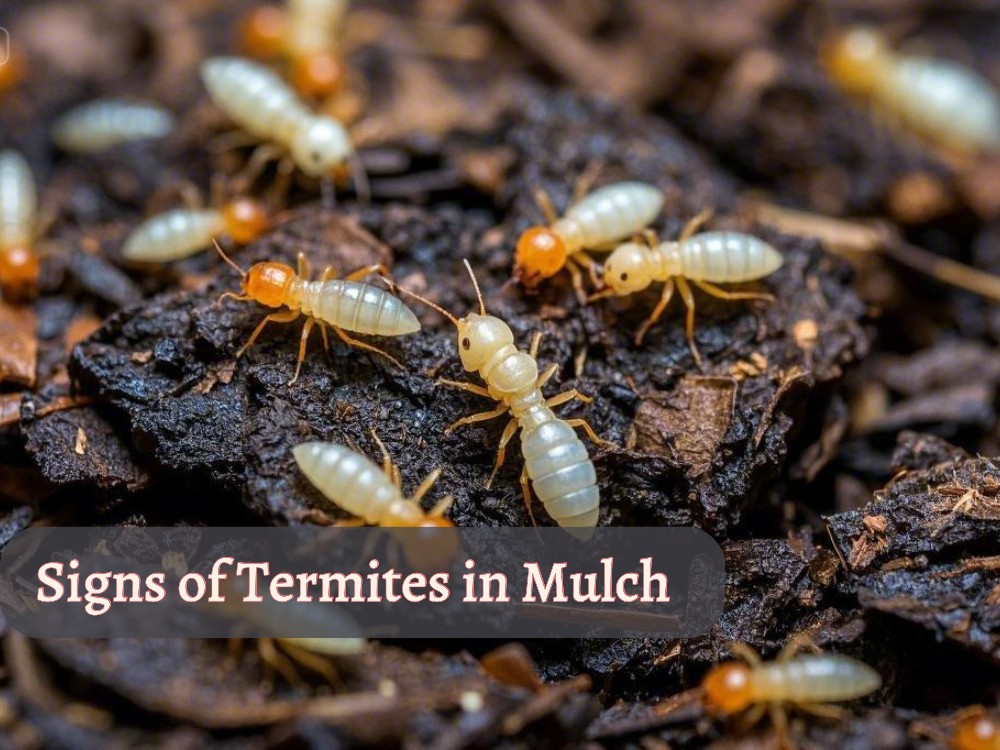Have you doubted that there are termites in my garden mulch? Or have you seen termites destroy your friend’s or relative’s garden, which happened to me🤭 And, like me, you are confused about whether a termite infestation has occurred somewhere in your garden.
However, there can be several reasons for presenting termites in the garden, including wooden materials, untreated mulch, decaying plant matter, and poor drainage.
When using mulch, many gardeners might worry about termite attacks, whether buying as mulch bags and piles or using it in raised beds or around (woody) plants.
Here, I will mention proven signs of termites in the mulch so that you can save your garden, plants, or bulk mulch. Stay with me and explore;
- Are Mulches Really Necessary for Plants
- What are The Termites?
- Does Mulch Attract Termites? What's the Reason Behind this?
- How Identify Termites Presentation in Mulch (Any Situation)?
- 1-Signs of Termites in Mulch Bags
- 2-Signs of Termites in Mulch Piles
- 3-Signs of Termites in Mulch Around Plants (Raised Beds)
- FAQ's
Are Mulches Really Necessary for Plants
Like other environmental factors, mulch is also crucial for plant growth. Depending on the mulch type, it retains moisture in plants, keeping them warm during winter and cold during summer.
In addition, mulch also maintains temperature control and provides vital nutrients to the soil. The main benefit of mulch is that it stops weed growth in your garden and soil erosion during rain.
As you are already familiar, mulch comes in various types, including wood, cypress, cedar, coca bean, rock, and rubber mulch. That’s why it is crucial to be aware of which mulch is termite-resistant.
Termite attacks have mostly been observed in wooden-based mulches, but due to high moisture levels, other mulch types can also suffer from termite damage.
What are The Termites?
Termites (Isopetera) are tiny insects, also called white ants! They are not real ants but relatives of cockroaches.
The research shows that termites are helpful in natural recycling and raising soil fertility but highly damage wood and buildings. They eat organic materials (wood, bark mulch branches, etc.)
Subterranean and damp wood termites mainly live in soil and find food and humid environments to stay alive.
They make mud tunnels in the soil and can reach mulch while researching food. The humidity and their basic food source (Cellulose) extremely attract them.
Does Mulch Attract Termites? What’s the Reason Behind this?
Before moving to signs of termites in mulch, recognize the exact answer of whether mulch attracts termites or not. So, mulch comes in two main types: organic and inorganic!
Organic mulch (wood, bark) provides food (Cellulose) and if the environment is also moist, termites can stay for a long time or make their homes.
Organic mulch: Food+Moisture= Termites’ nesting
On the other hand, inorganic mulch (rocks, gravel, rubber) is not a food source for them. However, they can take shelter there, if the mulch is damp and moist.
For example, rubber mulch does not provide any food to termites, and if it becomes too wet, termites can enter and stay for a short time. However, if the plants are woody, termites can reach them.
So, it is always recommended to keep a distance of 3 to 4 inches between mulch and plants and to avoid poor drainage.
Sings of Termites in the Mulch
Infestations of termites are very hidden and appear when the issue has increased, especially in buildings, furniture, and other wooden materials.
If you are worried that something in your mulch (that you have purchased in mulch bags, bought in bulk for landscaping, or you have recently applied around your plants in raised beds) may get termites risk, it is a great idea to check manually to save plants and home foundation.
How Identify Termites Presentation in Mulch (Any Situation)?
When using mulch for landscaping and gardening, every gardener may have one, two, or all situations. It might be that you have purchased mulch bags that have already been packaged.
It also can be that bulk mulch is placed in the corner of your garden or you have layered mulch newly around your plants normally or in raised beds.
So, let’s find out the signs of termites in mulch for all situations so that you can effectively check the presence of termites.
Remember! Mulch is mostly found in organic mulch (wood chips, bark, leaf, pine straw).
General Identification of Subterranean and damp wood termites
- Color: Light creamy to white brown
- Size: 1/8 inches to 1/2 inches
- Wings: Random, tiny wings in unusual spots, like a mulch bag.
- Hidden mud Tubs: Thin, muddy tunnels on mulch or soil on the surface
- Wood damage: Hollowed sound when a big piece of wood mulch tapped
- Soft Spot Check: Mulch or wood that feels spongy when pressed.
- Invisible Squeaks: Unexpected squeaky sounds when stepping on garden paths.
- Mini Wood Craters: Small holes in wood chips, like tiny craters.
- Mysterious Wood Dust: Fine, sand-like dust around plants or raised beds.
- Mulch condition: Chewed or crumbling mulch
- Moisture: Dampness under mulch or soil
